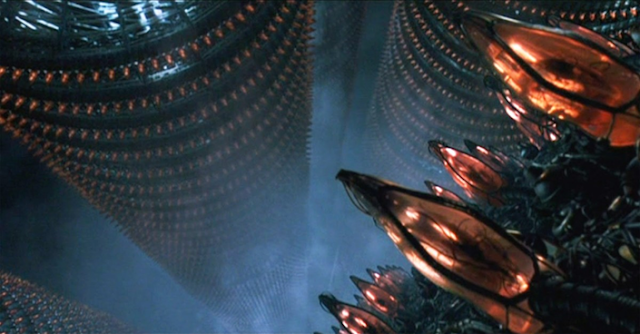The Martians in H.G. Wells’ The War of the Worlds (1898) resemble ad-funded social media companies in some ways.
Sweeney Todd, discussing baking people
into pies with Mrs Lovett (LyricsOnDemand)
Scrutinizing Intelligences
First, the opening sentences—Chapter I, “The Eve of the War,” in Book One, “The Coming of the Martians”:
No one would have believed in the last years of the nineteenth century that this world was being watched keenly and closely by intelligences greater than man’s and yet as mortal as his own; that as men busied themselves about their various concerns they were scrutinised and studied, perhaps almost as narrowly as a man with a microscope might scrutinise the transient creatures that swarm and multiply in a drop of water. With infinite complacency men went to and fro over this globe about their little affairs, serene in their assurance of their empire over matter. It is possible that the infusoria under the microscope do the same. No one gave a thought to the older worlds of space as sources of human danger, or thought of them only to dismiss the idea of life upon them as impossible or improbable.
Social media companies and their software tools to be intelligent even leaving aside the fact that they consist of thousands of intelligent people. They’re intelligent because they adapt to unpredictable changes in their environment (generated by user behavior, competitors and regulators) in order to meet their goals. One can debate whether their intelligence is “greater than man’s” like the Martians’. Their ability to process vast amounts of data in real time and to solve problems certainly makes it seem that way. They certainly keenly scrutinize and study all our doings.
On the other hand, unlike Wells’ oblivious Earthlings, we’re certainly aware of social media scrutiny. Many people frequently draw attention to social media as a source of danger to humans.
Blood-suckers
Next, a passage on Martian physiology from Chapter II, “What We Saw from the Ruined House,” in Book Two, “The Earth Under the Martians”:
Strange as it may seem to a human being, all the complex apparatus of digestion, which makes up the bulk of our bodies, did not exist in the Martians. They were heads—merely heads. Entrails they had none. They did not eat, much less digest. Instead, they took the fresh, living blood of other creatures, and injected it into their own veins.
Social media companies make a living off user attention: generating it and then streaming ads past it. Attention is the stuff of life, and the users’ attention streams become the companies’ data streams. This profiling data is then “metabolized” into ad revenue. [Endnote 1]
Wells conceives of the Martians’ ultimate goal as not to eradicate humans but to farm them. This is not completely alien to social media companies farming human attention. And it’s close to the underlying premise of the Matrix movies where machines confined humans to pods to harvest their bioelectric power.
 |
| The Matrix (i1.wp.com) |
Intelligence without Emotion
Also from Ch. II, “What We Saw from the Ruined House” in Book Two, “The Earth Under the Martians”:
To me it is quite credible that the Martians may be descended from beings not unlike ourselves, by a gradual development of brain and hands (the latter giving rise to the two bunches of delicate tentacles at last) at the expense of the rest of the body. Without the body the brain would, of course, become a mere selfish intelligence, without any of the emotional substratum of the human being.
Wells implies that this makes Earthlings superior to Martians: we have emotions, but they are “mere selfish intelligence.” That could true about social media companies, too. Few people consider even the most advanced AI to be sentient. Behavioral advertising algorithms don’t have bodies and thus can’t have emotions. [Endnote 2]
However, for those at the receiving end, emotions and sentience don’t matter—the actions they take do. While some institutions might be conscious (cf. Schwitzgebel’s If materialism is true, the United States is probably conscious), it’s more important that they have agency: they are differentiated, autonomous, interactive, and adaptive (cf. my Defining Agency).
And if it came to war?
Unlike the Martians, social media companies haven’t declared war on people – but how would we defend ourselves if they (or “AI”) did?
Perhaps Wells’s idea of bacteria as the surest defense might be the answer. For example, Shan & colleagues describe Nightshade, a data poisoning attack using images that “manipulate[s] training data to introduce unexpected behaviors into machine learning models at training time” (https://arxiv.org/abs/2310.13828). Unfortunately, our algorithms have been exposed to malware since the beginning, unlike the Martians, “slain by the putrefactive and disease bacteria against which their systems were unprepared” since “there are no bacteria in Mars, and directly these invaders arrived, directly they drank and fed, our microscopic allies began to work their overthrow”.
Trying to switch them off probably won’t work, if science fiction is to be believed. “Open the pod bay doors, HAL.”
Update, 4 Jan 2024: Added Amazon and Temu to endnote 1.
Endnotes
[1] A simple commercial-biological analogy to a food chain doesn’t work, though. (In the car business, say, raw materials are refined into metals; those metals are assembled into parts; those parts are combined into cars. Similarly, algae might photosynthesize carbohydrates; algae are eaten by shrimp; shrimp are eaten by fish.) Social media companies (and e-commerce sites like Amazon and Temu, too) are two-sided platforms, not links in a one-way value chain. Two-sided markets are third parties that bring buyers and sellers together.
GPT-4 suggested mutualism as a biological analogy. It brings together “buyers” and “sellers”; examples include bees get nectar to make honey, while flowers get pollinated; and ocean “cleaning stations” where cleaner fish or shrimp (service providers) remove and eat parasites and dead tissue from larger fish (clients). However, that still doesn’t get to a third-party platform extracting value through facilitating interactions. GPT-4 offered three examples but none of them really capture platform dynamics: (1) a fig tree (the multi-sided market) is the third party that facilitates the interaction between the fig wasps which need a place to reproduce and in so doing pollinate fig trees, and fruit-eating animals disperse seeds; (2) predatory fish at cleaning stations that don’t eat cleaner fish, thus maintaining a more healthy population of nicely-cleaned prey; (3) animals, like squirrels and birds, that disperse the spores of mycorrhizal fungi which help plants with nutrient absorption in return for carbohydrates. These are three-way mutualisms, perhaps, but not two-sided markets though the fig tree comes close.
 |
| Bing Image Creator |
[2] That will not necessarily always be the case, however. Algorithms may become embodied, but more interestingly, one might not need a body to have emotions. I lean towards the Damasio view of consciousness as higher order representations that correlate changes in the body with the objects that triggered these changes (cf. my Knowing with the Body). In this model, one doesn’t need a physical body to have consciousness, just (1) a representation of self, (2) a representation of outside objects, and (3) a representation of co-occurring changes in (1) and (2). This could all be in software, and so digital systems could be conscious in the Damasio sense.

No comments:
Post a Comment